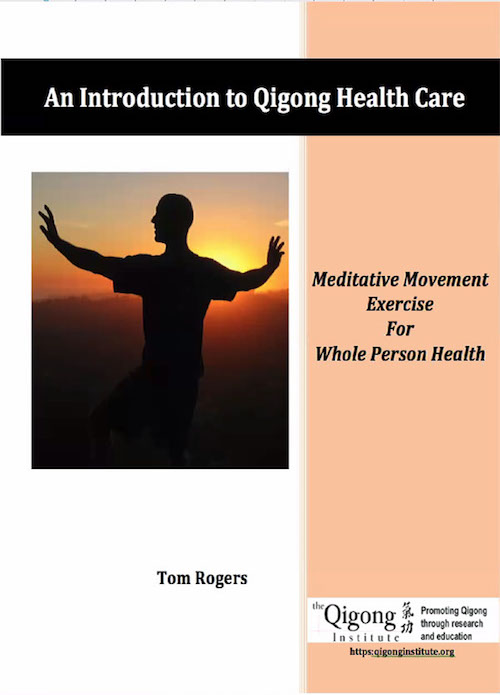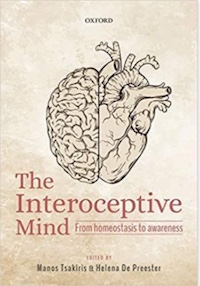Interoception
Qigong practice consists of quieting the mind through mindfulness, thus enabling an enhanced interoception, proprioception, vestibular system, awareness of present moment experience, and emotional regulation. Learning to have present moment awareness of and attention to the body without distractions such as thoughts is a mindfulness skill. Interoception is the underlying neurological mechanism of mindfulness-based approaches to meditation. Clinical research describes mindfulness as the attentional focus necessary and fundamental for gaining interoceptive skills (PMC6753170). The refined ability to sustain awareness characterizes what in Qigong is called cultivating the skill of self-observation and regulating emotional responses to bodily sensation.
Interoception refers collectively to the processing of internal bodily stimuli by the nervous system and includes physical responses in body and brain representation such that the sensing of stimuli is available for reflection, insight, conscious awareness, and action. This characteristic training of awareness makes Qigong an “interoceptive awareness practice.” Interoception is such a new field of psychophysiological study that its first international conference was held in 2016. The National Center for Complementary and Integrative Health (NCCIH) is focusing on the multidisciplinary study of interoception science as a way to research "mind-body" practices, including Qigong.
Interoception, a key component of Qigong practice, is a representation of the body's internal state and bodily signals based on proprioception, the senses, and biofeedback pathways which include bi-directional communication between the limbic system (thoughts and emotions), the frontal cortex, the neuroendocrine system, and the autonomic nervous system. Interoception is essential for physiological homeostasis, cognition, and emotional regulation. Interoceptive awareness is a pre-requisite for emotional regulation.
Multidimensional Assessment of Interoceptive Awareness Version 2 (MAIA-2). Measuring interocepton. PMCID: PMC6279042.
Interoceptive rhythms in the brain. Sensing internal bodily signals, or interoception, is fundamental to maintain life. However, interoception should not be viewed as an isolated domain, as it interacts with exteroception, cognition and action to ensure the integrity of the organism. Focusing on cardiac, respiratory and gastric rhythms, we review evidence that interoception is anatomically and functionally intertwined with the processing of signals from the external environment. Interactions arise at all stages, from the peripheral transduction of interoceptive signals to sensory processing and cortical integration, in a network that extends beyond core interoceptive regions. Interoceptive rhythms contribute to functions ranging from perceptual detection up to sense of self, or conversely compete with external inputs. Renewed interest in interoception revives long-standing issues on how the brain integrates and coordinates information in distributed regions, by means of oscillatory synchrony, predictive coding or multisensory integration. Considering interoception and exteroception in the same framework paves the way for biological modes of information processing specific to living organisms. PMID: 37697110.
Interventions and Manipulations of Interoception. Interoceptive pathways may be manipulated at various levels to develop interventions to improve symptoms in a range of disorders. Primarily through the lens of the respiratory system, we outline various pathways that can be manipulated at neural, behavioral, and psychological levels to change the representation of and attention to interoceptive signals, which can alter interconnected physiological systems and improve functioning and adaptive behavior. Interventions can alter interoception via neuromodulation of the vagus nerve, slow breathing to change respiratory rate and depth, or awareness processes such as mindfulness-based interventions. PMC7805576.
Interoception: A Multi-Sensory Foundation of Participation in Daily Life. The purpose of this article is to examine evidence that broadens the clinical perspective on interoception as an imperative consideration for individuals with mental health and sensory processing challenges. The central supposition is that interoception is broader than just signals from the viscera. Rather, interoception refers to perceptions of bodily signals and bodily states that construct a subjective representation of the experience. These representations are then utilized for categorizing the sensory attributes and constructing meaning. This is an extremely detailed description and analysis of interoception. PMCID: PMC9220286.
The Emerging Science of Interoception: Sensing, Integrating, Interpreting, and Regulating Signals within the Self. Interoception refers to the representation of an organism’s internal states, and includes the processes by which it senses, interprets, integrates, and regulates signals from within itself. This review article presents a unified research framework and attempts to offer definitions for key terms to describe the processes involved in interoception PMCID: PMC7780231.
Unravelling the Neurobiology of Interoceptive Inference. What is the function of the insular cortex? Two recent studies (by Gehrlach et al. and Livneh et al.) offer new insight into how this enigmatic brain region integrates interoception and exteroception in the service of emotion. The findings provide much needed causal evidence for the nascent theory of interoceptive inference PMID: 32160563.
Mindfulness, Interoception, and the Body: A Contemporary Perspective. The purposes of this article are to (1) highlight that it may be more accurate to link many of the identified benefits in the mindfulness literature to interoception and its neurological correlates and (2) propose attentional style as a means to clarify some of the confusion surrounding mindfulness, interoception, and meditation. Different meditations require different attentional styles. Some of the confusion surrounding mindfulness is believed to stem from an undifferentiated use of the term mindfulness and meditation. There is no universally accepted technical definition of “mindfulness” nor is there a consensus on various aspects underlying the concept to which it refers PMCID: PMC6753170.
Longitudinal effects of interoceptive awareness training through mindful awareness in body-oriented therapy (MABT) as an adjunct to women's substance use disorder treatment: A randomized controlled trial. Both MABT and Qigong train interoceptive awareness over time. MABT and Qigong teach interoceptive awareness skills to promote self-care and emotion regulation PMCID: PMC6467707.
Interoception and Social Connection. Meditation practices that include mindfulness (e.g. Qigong) are important for alleviating loneliness and improving social connection PMCID: PMC6901918.
A Positive Emotional-Based Meditation but Not Mindfulness-Based Meditation Improves Emotion Regulation. This research confirms a fundamental feature of Qigong practice. Qigong meditation begins with mindfulness to focus on present awareness, but what happens next is more important. Unlike mindfulness alone, Qigong practice trains interoception which is intricately related to emotional processing. Of particular interest is the Multidimensional Assessment of Interoceptive Awareness Version (MAIA). Qigong and Tai Chi practice increase interoceptive awareness which in turn contributes to enhanced health and wellness PMCID: PMC6448484.
Self-control is linked to interoceptive inference: Craving regulation and the prediction of aversive interoceptive states induced with inspiratory breathing load. The interoceptive inference framework suggests that our brain continuously anticipates future states of our body and aims to avoid events that might counteract homeostasis by minimizing prediction errors through active inference; e.g. appropriate actions. If predicted interoceptive models are inaccurate, behavior inconsistent with our long-term homeostatic goals may result; e.g. in failures in self-control and emotional regulation PMID: 31330380.
The neurobiology of interoception in health and disease. Interoception is the sensing of internal bodily sensations. Interoception is an umbrella term that encompasses (1) the afferent (body-to-brain) signaling through distinct neural and humoral (including immune and endocrine) channels; (2) the neural encoding, representation, and integration of this information concerning internal bodily state; (3) the influence of such information on other perceptions, cognitions, and behaviors; (4) and the psychological expression of these representations as consciously accessible physical sensations and feelings. Interoceptive mechanisms ensure physiological health through the cerebral coordination of homeostatic reflexes and allostatic responses that include motivational behaviors and associated affective and emotional feelings PMID: 29974959.
Interoception and Mental Health: A Roadmap. This is a summary of the first international conference on Interoception, the Interoception Summit 2016]. Interoception refers to the process by which the nervous system senses, interprets, and integrates signals originating from within the body, providing a moment-by-moment mapping of the body's internal landscape across conscious and unconscious levels. Interoceptive signaling has been considered a component process of reflexes, urges, feelings, drives, adaptive responses, and cognitive and emotional experiences, highlighting its contributions to the maintenance of homeostatic functioning, body regulation, and survival. Dysfunction of interoception is increasingly recognized as an important component of different mental health conditions, including anxiety disorders, mood disorders, eating disorders, addictive disorders, and somatic symptom disorders. Recent years have witnessed a surge of interest on the topic of interoception due in part to findings highlighting its integral role in emotional experience, self-regulation, decision making, and consciousness PMCID: PMC6054486.
Interoceptive Inference: From Computational Neuroscience to Clinic. The central and autonomic nervous systems can be defined by their anatomical, functional and neurochemical characteristics, but neither functions in isolation. For example, fundamental components of autonomically mediated homeostatic processes are afferent interoceptive signals reporting the internal state of the body and efferent signals acting on interoceptive feedback assimilated by the brain. Recent predictive coding (interoceptive inference) models formulate interoception in terms of embodied predictive processes that support emotion and selfhood. We propose interoception may serve as a way to investigate holistic nervous system function and dysfunction in disorders of brain, body and behaviour. We appeal to predictive coding and (active) interoceptive inference, to describe the homeostatic functions of the central and autonomic nervous systems PMID: 29694845.
Interoceptive Awareness Skills for Emotion Regulation: Theory and Approach of Mindful Awareness in Body-Oriented Therapy (MABT). Emotion regulation involves a coherent relationship with the self, specifically effective communication between body, mind, and feelings. Effective emotion regulation involves the ability to accurately detect and evaluate cues related to physiological reactions to stressful events, accompanied by appropriate regulation strategies that temper and influence the emotional response. There is compelling evidence demonstrating links between poor or disrupted awareness of sensory information, or interoceptive awareness, and difficulties with emotion regulation. This paper presents a framework, based on psychological and neurobiological research, for understanding how interoceptive awareness facilitates regulation and an integrated sense of self, and thus contributes to health and well-being PMCID: PMC5985305.
Increasing Our Insular World View: Interoception and Psychopathology for Psychotherapists. Interoception has been determined to be an elemental aspect of the neural foundations of physiological homeostasis, subjective experience, and motivated behavior. This paper reviews current neuroscience research regarding interoception and forms of interoceptive dysfunction that may result in psychopathology, focusing on depression, and anxiety, in a manner conducive to psychotherapists engaging with it to consider clinical applications PMCID: PMC5359279.
Interoception and stress. Interoception and stress are, therefore, associated via the bi-directional transmission of information on the brain–body axis. It could be argued that excessive and/or enduring activation (e.g., by acute or chronic stress) of neural circuits, which are responsible for successful communication on the brain–body axis, induces malfunction and dysregulation of these information processes. As a consequence, interoceptive signal processing may be altered, resulting in physical symptoms contributing to the development and/or maintenance of body-related mental disorders, which are associated with stress PMCID: PMC4507149.
Interoception, Contemplative Practice, and Health. Well-being is deeply rooted in the body, a continuous flow of feelings denoting comfort or distress. Interoception, the representation of the body's internal state, is a growing target of scientific research, buoyed by a growing respect for contemplative traditions relating interoceptive awareness to the cultivation of well-being. An emerging interoception literature cuts across studies of neurophysiology, somatic anthropology, contemplative practice, and mind-body medicine. This paper reviews interdisciplinary perspectives on interoception, with the goal of presenting a unified perspective from diverse fields such as neuroscience, clinical practice, and contemplative studies. It introduces an expanded taxonomy of interoceptive processes, arguing that many of these processes can be understood through an emerging predictive coding model for mind–body integration. The model, which describes the tension between expected and felt body sensation, parallels contemplative theories, and implicates interoception in a variety of affective and psychosomatic disorders. We conclude that maladaptive construal of bodily sensations may lie at the heart of many contemporary maladies, and that contemplative practices may attenuate these interpretative biases, restoring a person’s sense of presence and agency in the world PMCID: PMC4460802.
Mindfulness meditation training alters cortical representations of interoceptive attention. One component of mindfulness training is the development of interoceptive attention to visceral bodily sensations, facilitated through daily practices such as breath monitoring. PMCID: PMC3541492.
The Multidimensional Assessment of Interoceptive Awareness Version (MAIA). Qigong and Tai Chi practice increase interoceptive awareness which in turn contributes to enhanced health and wellness. This paper gives an excellent background on the processes of interoception which include awareness of body sensations, emotional reaction and attentional response to sensations, capacity to regulate attention, trusting body sensations and beliefs about importance of sensations, and mind-body integration PMCID: PMC3486814.





